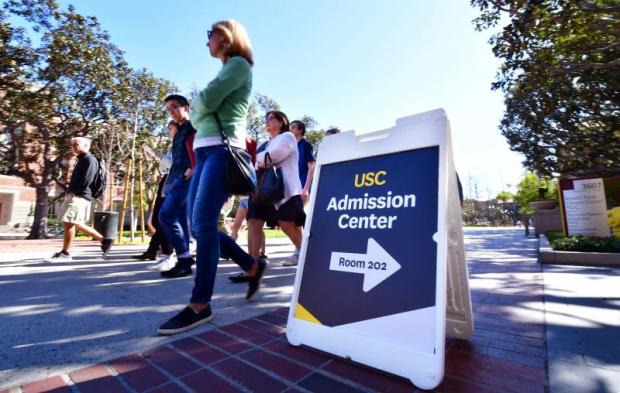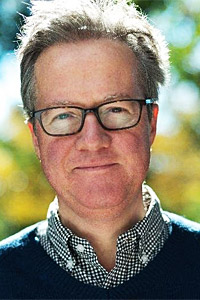
Of the 839,730 recipients of bachelor's degrees in the US in the 1970-1971 academic year, 176,307 got education degrees. Other big fields of study included the social sciences, business and English.
In 2016-2017, nearly 2 million bachelor's degrees were awarded. Most of the top 10 majors from 1970-1971 were still in the top 10, but the order had changed a lot.
To give a better sense of how and when the distribution has changed over time, here are the trajectories of the four fields of study that made it into double digits.
Some of the biggest shifts happened in the 1970s, driven in large part, as University of British Columbia historian Heidi Tworeck described a few years ago, by women entering college in large numbers (they received the majority of bachelor's degrees for the first time in the early 1980s) and then busting out of the narrow range of majors such as education and English to which they had initially been confined.
The business category, which includes such majors such as accounting, human resources and marketing, seized the No.1 spot in the late 1970s and has held it since, although it reached peak popularity during the era of Ronald Reagan and Alex Keaton, which is a nice touch. The most significant development of this century, meanwhile, has been the rise of the health professions.
Of the 238,014 bachelor's degrees in health professions and related programmes awarded in 2016-2017 (about half were in registered nursing), 84% went to women. Women accounted for 57% of bachelor's degrees overall, 47% of those in business, 50% in social sciences and history, and 81% in education. Education degrees have been in a long decline, so to some extent what has happened is that women switched from teaching to health care. They had good financial reason to do so: A report on "The Economic Value of College Majors" from Georgetown University's Center on Education and the Workforce found that workers ages 25 to 49 who had majored in health-related subjects made an average of US$65,000 a year in 2013 (the same as business majors), while those who majored in "teaching and serving" fields made $46,000.
Employment has also grown much faster in health care than in the rest of the economy, and is projected by the Bureau of Labor Statistics to continue doing so. Meanwhile, the Economic Policy Institute reports that the teacher wage penalty -- how much less teachers are paid relative to workers with comparable education, experience and other characteristics -- hit an all-time high of 21.4% in 2018.
Another shift of note has been away from the traditional humanities. English language and literature was the fourth-most popular field of study in 1970-1971, accounting for 7.6% of bachelor's degrees. By 2016-2017, it had fallen to 15th place, at 2.1%. And while social sciences and history remains in the top three, its share is less than half what it was in 1970-1971. History by itself now accounts for just 1% of bachelor's degrees, down from more than 5% in the late 1960s and also down markedly in the past decade, as Northeastern University historian Benjamin M. Schmidt documented in a study that got a lot of attention late last year. Hybrid humanities and liberal arts majors, visual and performing arts programmes, and new fields such as gender and group studies have replaced some of that share but not nearly enough to stem the overall decline. All the ethnic, cultural minority, gender and group studies majors put together, in fact, accounted for just 0.2% of bachelor's degrees awarded in 2016-2017.
I mention that last statistic because such programmes are often the target of critics who wish to paint modern academia as overly political and inadequately practical. Some parts of it may well be, but the majors that have seen the most growth in recent years have tended very much toward the practical.
In case you were wondering, multi/interdisciplinary studies degrees come in many different flavours, the most popular of which is international/global studies, with behavioural sciences, biological and physical sciences, and nutrition sciences also attracting lots of students. Other than that, the list above is dominated by (1) STEM (science, technology, engineering and math) majors and (2) tightly targeted vocational majors. Yes, "parks, recreation, leisure and fitness studies" sounds a little goofy, but half those degrees are in "kinesiology and exercise science," which is to some extent yet another health profession -- and seems like a practical enough thing to study in a country with a gigantic sports-industrial complex and a 33.6% increase in health club memberships since 2008.
Whether it's too practical is something I don't have an answer for. As hinted above, those humanities enrolment numbers from the early 1970s were inflated to some extent by the fact that women didn't feel welcome in other fields. The earliest American colleges started out as vocational schools for ministers, while the land-grant universities were created chiefly "to teach such branches of learning as are related to agriculture and the mechanic arts." Yes, college can be a wonderful mind-expanding place where students gain "the ability to think critically and independently." But it's never been entirely, or even mainly, about that.
These degree statistics, then, are probably best seen not as evidence of the closing of the American mind (or some such) but as the joint product of students' and colleges' attempts at puzzling out what will be useful and remunerative to know in the future. For the moment, they seem to be betting on business and health care. ©2019 BLOOMBERG OPINION
Justin Fox is a Bloomberg Opinion columnist covering business. He was the editorial director of Harvard Business Review and wrote for Time, Fortune and American Banker.
